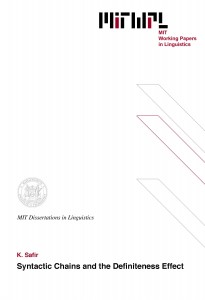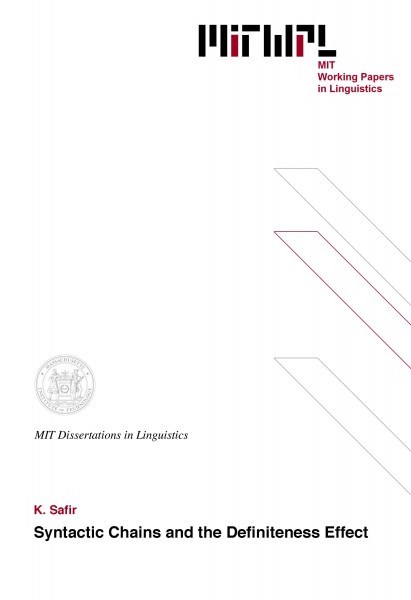Syntactic Chains and the Definiteness Effect
K. Safir, 1982
This study investigates the role of syntactic chains, more specifically “θ-chains,” in grammatical theory. Very roughly speaking, a “θ-chain” is a set of positions sharing the same semantic role, or “θ-role,” wherein each higher member of the chain “binds” each lower member. “Binding” assumed to consist of C-command and coindexing. A central hypothesis of this study, expressed as the “Unity of Indexing Hypothesis,” asserts that the notion of “binding” relevant to the formation of θ-chains is exactly the same notion of “binding” relevant to the conditions on anaphora, Chomsky’s (1981a) “Binding Conditions” (BC’s).
In the first two chapters, this study is put into the wider context of recent research, and several central principles are introduced, defined, and individually motivated, most notable among these, θ-chains and the UIH. Additional principles that interact directly with θ-chains, such as Case inheritance, the Empty Category Principle, and the θ-criterion, add a range of diagnostic consequences to the formation (or non-formation) of θ-chains in a given context. Moreover, since the UIH requires that binding for θ-chain formation correlate with binding for the BC’s the ill-formedness of a wide range of otherwise possible analyses is predicted. The remainder of this research assesses the consequences of the UIH in contexts where formation of a θ-chain, independently required by other principles, such as the Case Filter and the θ-criterion, would create an instance of binding that violates the BC’s.
In Chapter III, for example, it is argued that there is no θ-chain relation between it and S’ in the construction commonly known as “it-extraposition.” This conclusion leads to a revision of the Case Filter, the introduction of the “Case Realization Conditions,” the motivation of an additional principle excluding S’s from case-marked θ-chains, and the postulation of the “external θ-set,” an analysis which permits the assignment of an “external” θ-role to either preverbal subjects of VP-adjoined subject (both sisters of VP).
In Chapter IV, the consequences of the UIH are examined with respect to there-sentences in English and impersonal constructions in many languages. In these contexts, it will be argued, the Case Filter requires that a θ-chain be formed to permit Case inheritance, but the resulting θ-chain contains a violation of the BC’s. The mediation of this conflict results in what is commonly known as the “Definiteness Restriction”, or, as I shall call it, the “Definiteness Effect” (DE). Chapter IV demonstrates that the distribution of the DE correlates exactly with the formation of “unbalanced” θ-chains of this sort. An attempt to explain why unbalanced θ-chains can be saved by indefiniteness, as opposed to some other property, is developed in Chapter V, and the formal expression of the definite/indefinite distinction is further motivated and integrated within a theory of the LF component.
Given the above analysis, the absence of the DE ought to correlate exactly with the absence of an unbalanced θ-chain. Precisely this implication is examined with respect to free inversion in Italian, where no DE holds. Contrary to most recent accounts, I shall demonstrate that no unbalance θ-chain need be formed to permit postverbal definite subjects in Italian, as no Case inheritance is required to satisfy the Case Filter (rather NOM(inative) Case is assigned directly to the postverbal position by the effect of the “Free Inversion Parameter”) and θ-assignment to the postverbal subject is direct under the “external θ-set” proposal mentioned above. It is also demonstrated that “free inversion” and “missing subjects” result from separate parameters rather than from a single so-called “PRO-drop Parameter,” and that the four types of possible languages predicted by the existence of separate parameters are in fact evidenced among the Romance languages. The parameter responsible for missing subjects, the NOM-drop Parameter, is then extended to German wherein only expletive subjects can be missing, exactly as predicted by the revised inventory of empty categories proposed in Chapter II and VI, and the assumption that German lacks clitics parallel to those in Romance languages.
Table of Contents
Chapter I
1.0 Grammatical theory and syntactic theory 12
1.1 The theory of grammar 13
1.2 The vocabulary of syntactic relations 15
1.3 From systems of rules to systems of principles 20
1.4 Subtheories of grammar: Case Theory 24
Footnotes 29
Chapter II
2.0 Indexing and syntactic chains 32
2.1 Indexing in generative grammar: a historical sketch 33
2.2 The unity of indexing hypothesis 36
2.3 Syntactic chains 47
2.4 Indexing and empty categories 56
2.4.1 The functional definitions of Empty Categories 56
2.4.2 Expletive empty elements 61
2.4.3 Relations between components 69
2.4.4 Expletivity and the inventory of Empty Categories 83
2.5 Constraints at LF-structure 86
2.5.1 The domain of ECP 87
2.5.2 ECP and EXE 91
2.5.3 The domain of the ECP: further consequences 97
2.6 Summary 103
Footnotes 104
Chapter III
3.0 Case theory and clausal arguments 113
3.1 Case and the θ-criterion 114
3.2 S’ Complements 118
3.2.1 Must S’ be casemarked? 120
3.2.2 S’ and θ-chains 125
3.2.3 The revised case filter and the case realization conditions 131 3.3 Variables and case 137
3.4 Can S’ be casemarked 143
3.5 Summary 152
Footnotes 154
Chapter IV
4.0 The distribution of the definiteness effect 164
4.1 The phenomenon 166
4.1.1 Earlier analyses 167
4.1.2 θ-chains and the definiteness effect 172
4.2 French Il impersonals 175
4.3 German and Dutch impersonals 181
4.3.1 Some analytic assumptions 181
4.3.2 Prepositional objects and dative objects 186
4.3.3 Nominative/dative inversion 189
4.3.4 Nominative/dative inversion and the INPP 196
4.4 The list interpretation and presentational impersonals 200
4.4.1 IBE, PBE, and the list interpretation 201
4.4.2 Ergative impersonals and presentational impersonals 209
4.5 Summary 219
Footnotes 221
Chapter V
5.0 Towards and explanation of the definiteness effect 236
5.1 The proposal 237
5.1.1 Motivating the INPP 238
5.1.2 The context of grammatical levels 239
5.1.3 Impersonal insertion 245
5.2 Some questions of analysis 250
5.2.1 QR and the scope of negation 251
5.2.2 Raising and lowering 257
5.2.3 Wh-movement in there-sentences 266
5.2.4 Summary of 5.2 277
5.3 Definiteness and indefiniteness 278
5.3.1 Contextual tests for definiteness 278
5.3.2 On the semantic treatment of definiteness 285
5.4 Towards and explanation of indefinite NP properties 290
5.5 Summary 295
Footnotes 296

